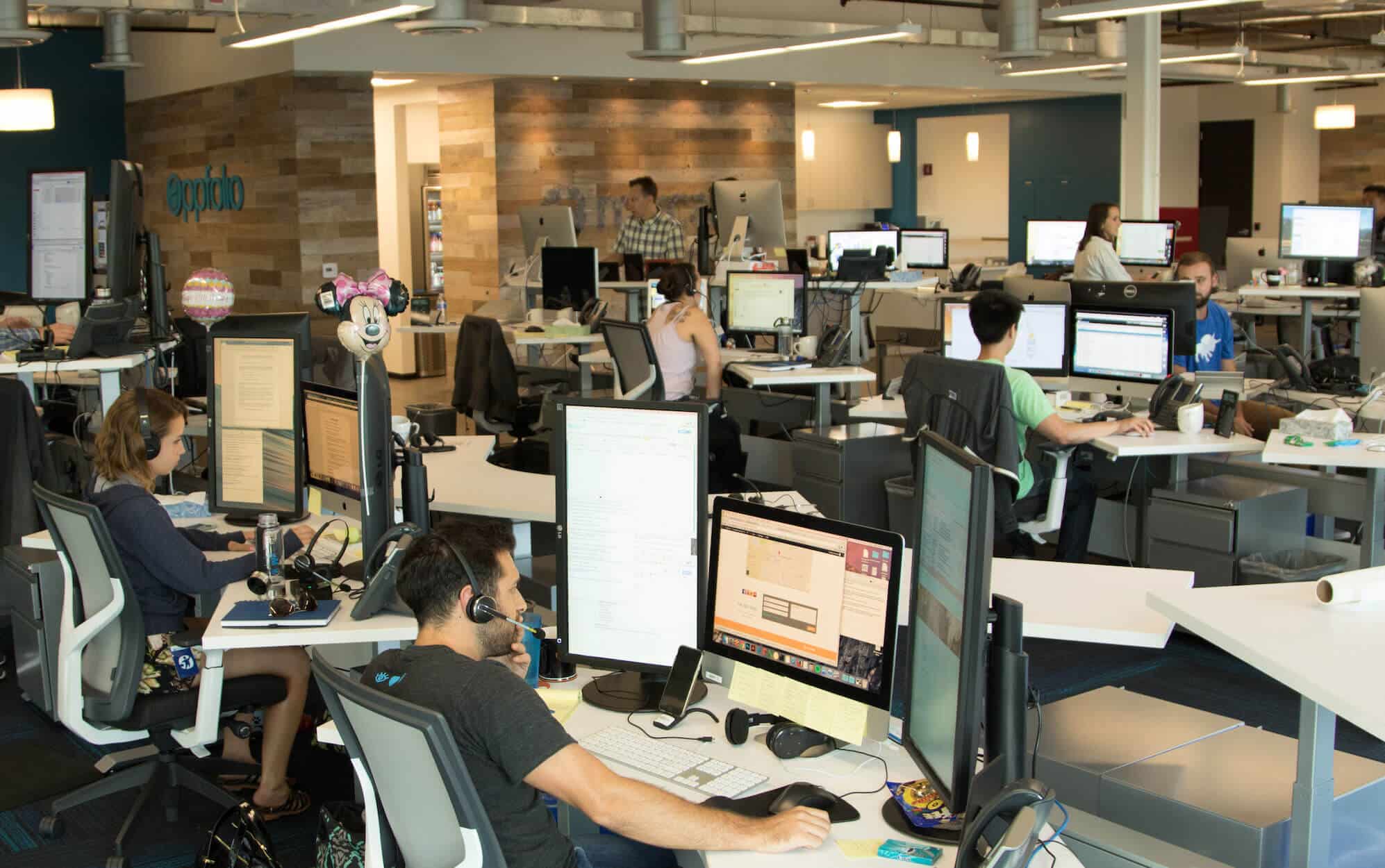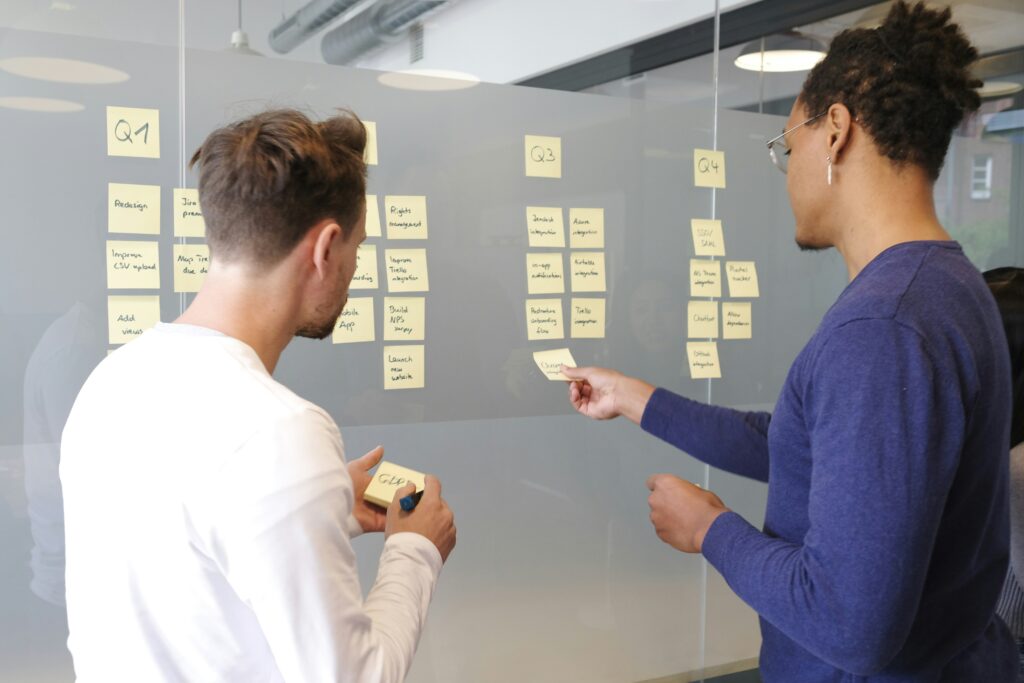I have been a part of two successful startups and product development teams for the past 17 years. The first was acquired and thrives today with products such as GoToMeeting and GoToWebinar. The second one, AppFolio, went public and also thrives with its software for property management companies and law firms.
The key takeaway from watching each of these companies grow from roughly 10 employees to 600+ each is this: It’s all about building relationships. It is just like exercise. If we exercise regularly, a side effect is that our diet typically improves. If we build relationships and really know and care about the people we work with, everything else comes easier.
So how can we build relationships on our product development teams and thrive? Here are five ways.
1. Sit Together
At my first startup, engineering and product development teams sat separately, and we all had our own individual offices. As our departments grew, we were spread even farther from each other. As a result, informal interactions between different groups went away, or became more challenging. Our communication would primarily take place over email or on the phone. Our engineering and product groups would only meet weekly or biweekly to review progress. We’d attempt to “be on the same page”, and that “page” was typically a schedule expressed in Microsoft Project. We weren’t exactly “strangers” but we really didn’t “know each other”.
We learned — when we don’t see the people we work with on a regular basis, we make assumptions and distance grows — “us” and “them”; and “we” and “they” language emerges. Working together becomes harder.
Years later at AppFolio, my second startup, we hired Jason, the product manager I worked with closely at the first startup. At that time, our entire company was in one room with an open floor plan. We’d have casual conversations, and share the antics of pranking people’s desks when they went out on vacation. Once when Jason was out we upgraded his computer with the latest hardware from the 80s as shown below! We were all thrilled when our property manager software was fired up on his screen. It was a fun moment for everyone, including Jason. It felt like we were all on “one team” when we were in the same room.

Jason returns from vacation to find a “state-of-the-art” computer setup on his desk.
I remember reflecting with Jason about being together with our groups in the same space at AppFolio versus being in different wings of a building when we were at the first startup. From there, we made a pact that our groups — engineering and product — would all sit together in the same open space going forward. It’s now about nine years later, and we still work in open areas and are together as cross-functional teams of engineers, QA, UX, product managers, and agile coaches.

Example of a cross-functional team area at AppFolio.
Sitting together does not come easy if there are remote teams and offices. Workarounds such as Google Hangouts and GoToMeeting are available to help in such situations. We promote the use of video for our remote friends as it helps to level the playing field and bring us closer.

View of our satellite office via Google Hangouts at AppFolio headquarters.

View of AppFolio headquarters on screen via Google Hangouts from our LA office.
2. Actively get to Know Each Other and Build Trust
Doing activities to help get team members to know each other on a personal basis is an incredible strategy for team-building and raising the level of respect on teams.
At AppFolio, when we reteam or change up team membership, we have deliberate discussions about how we want to “be together” as a team. We determine what we want it to be like in our physical team spaces. We elicit team members’ preferences regarding communication and interruptions, and vision out the characteristics for our team in order to flourish. This includes understanding how we will operate when things get difficult. Because they “will” get difficult. This raises the positivity in the environment and makes conflict easier to bear. Examples are: team members’ desire to go together for a walk outside if they have a conflict, or to give “alone time” to someone you overheard having a challenging phone call. The book, Creating Intelligent Teams by Anne Rød and Marita Fridjhon, gets into the specifics of designing “team contracts” like mentioned above.
We also do many other activities to deliberately enhance the experience of getting to know one another and build trust. One of them is a modified version of the Market of Skills activity from Lyssa Adkins’s book, Coaching Agile Teams. If you walk through AppFolio today you are likely to find one of these Market of Skills posters hanging on a wall or the side of a desk.
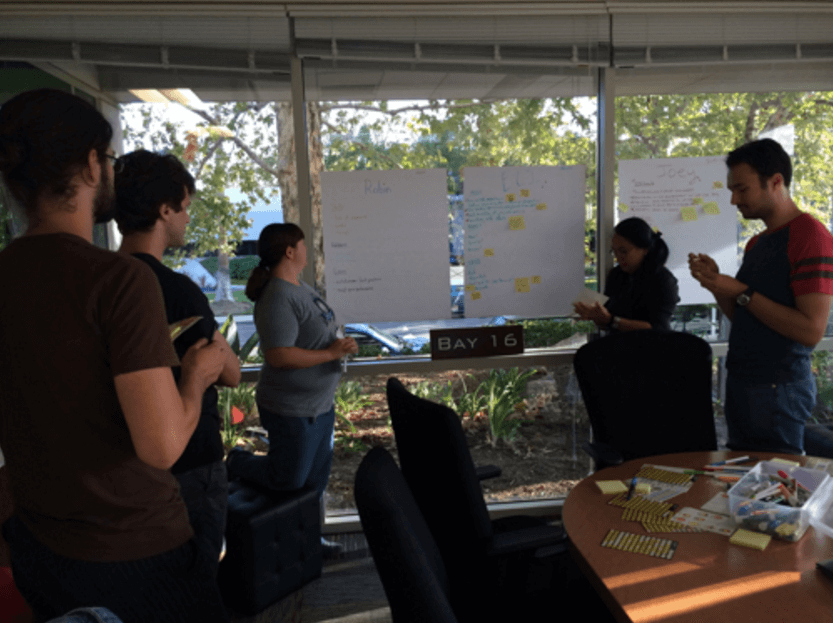
Team getting to know each other via Market of Skills activity at AppFolio.
We also go on short outings together as a cross-functional team. We are fortunate to be located in Santa Barbara, California. I like to take teams out on hikes and combine it with sharing personal stories to bring us all closer.
A favorite activity of mine is a “Fulfillment Hike”, an activity inspired by “Co-Active Coaching”. In this activity, we share with each other a “peak experience” in our lives about something that is personally meaningful to us. At the top of the hike, we stand or sit in a circle, and go around sharing the stories we heard from our partners. Together we derive the values from each of our stories and have a discussion about which values we would like to carry over into our daily work. We put up these values on a poster in our team area as a reminder of what we want.
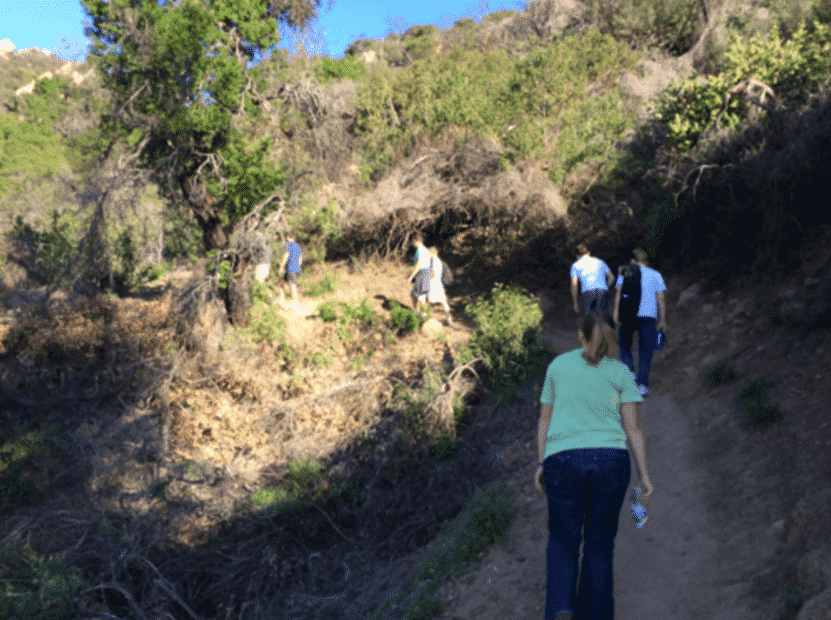
Photo of cross-functional team on a hike up Inspiration Point trail in Santa Barbara.
By actively getting to know each other, we can empathize well with each other and can build great trust and camaraderie.
3. Share and own Challenges Together
During the early years of my first startup, waterfall-style development was the norm. Unable to predict, product development teams would promise a deadline but deliver late. Discussions about this topic were extremely stressful and difficult. The saving grace of this type of thing was to cut back scope (ideally) in order to get as close to the committed date as possible. Conversations about this topic between engineering and product groups couldn’t just happen on the fly. They needed to be “scheduled” due to the distance between our groups. This took time and elevated tensions among our groups.
We learned that our practices prevented us from sharing and owning challenges together. We had to fix that.
Fast forward to AppFolio… due to physical proximity and actively getting to know one another, product managers and engineers are more open and honest with each other. Product managers get a daily or even hourly understanding of where things are at. Everyone is present together in their work-area and at regular team events. We can even discuss our work challenges during a team hike while going through a physical challenge. The chance of having negative surprises is greatly reduced.
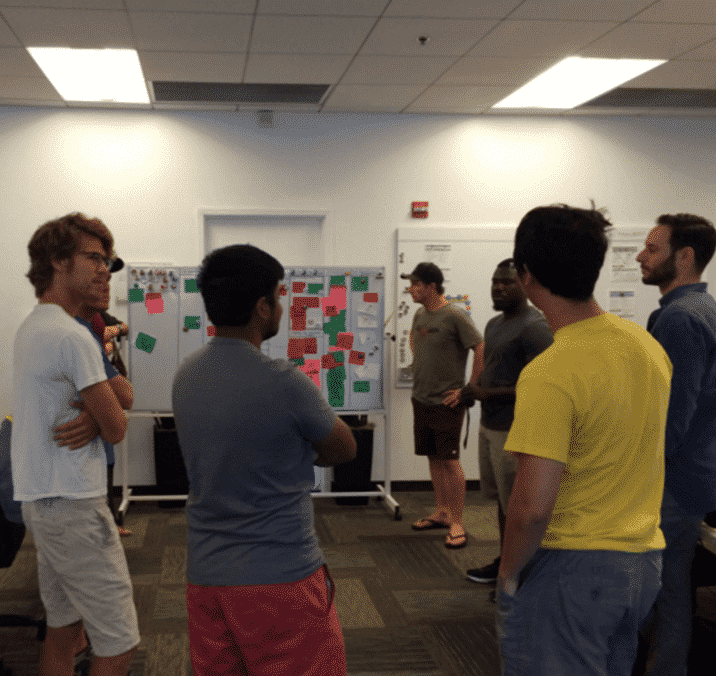
Example of product development teams discussing work visualized on a board in their team area.
Cross-functional product development teams can also share the challenge of onboarding new team members. When team members share the mentorship of a new employee, the load is lighter. And, the person being mentored gets more attention, and is exposed to different styles of working. This can include cross-group mentoring. For example, experienced engineers can help out in mentoring new and experienced product managers.
In summary, we are stronger when we face challenges together — regardless of what group we are in, or what reporting structure we have. Helping each other succeed helps us realize our goal of delighting our customers with our product development roadmap.

4. Help Each Other Succeed
I remember talking to our AppFolio co-founder and CTO Jon Walker about a challenge I was having with a fellow team member. He looked at me and said, “Heidi, how can you make this person successful?” That simple phrase changed everything for me, and I’ve come back to it over and over again as I coach people around me. When we hire people, we want them to thrive and be successful. That’s why we hired them. Helping to educate team members on this simple yet powerful topic can make an incredible impact. When I hear complaints about another person, I even find myself echoing Jon by saying, “How can you help them be successful?”
When I mentor people at AppFolio I like to teach them the concept of Net Promoter Score (NPS) applied to us as individuals. We use the concept of NPS with our AppFolio customers on a regular basis. It tells us how likely our customers are to recommend our software to other people, as well as collects qualitative comments that we analyze for improving our products. It comes from the book The Ultimate Question by Fred Reichheld. When applied to people, I encourage people to think about their behavior and actions and how they think others might perceive them in their teams and outside their teams. Are they “creating promoters” for themselves? What are the chances that their behavior will be championed by other people around them?
Teaching team members tools and techniques for communication challenges they are experiencing is a great way to support them and to help them grow. In recent days I have been teaching managers techniques to use with people on their team to help prepare them for having what they perceive as “difficult” conversations with others. We do an empathy building exercise based on a modified “3rd entity” activity from Organizational Relationship Systems Coaching (ORSC).
When you reteam at AppFolio, you have the opportunity to work and learn together with different people. But you might be used to the style of a particular team member and expect that the people on your new team will act in the same manner. This is the type of scenario you face with a fast-growing company like ours. Deliberately promoting the attitude to help one another encourages everyone to be “in it” together. This might mean building more patience and helping fellow team members along the way that are new to their roles. It also might mean putting our named “roles” aside and doing whatever to help the endeavor move forward.
5. Have Outings and Learn Together
At the first startup, we had the tradition of having annual retreats where our engineering department would go camping, white water rafting or some other trip typically involving the outdoors. The tradition originated, according to our founder Klaus Schauser from an experience he had with a student group that he was a part of at UC Berkeley. AppFolio was co-founded by Klaus, and when we were a startup we continued this tech retreat tradition, starting with our inaugural retreat white water rafting on the Kern river.
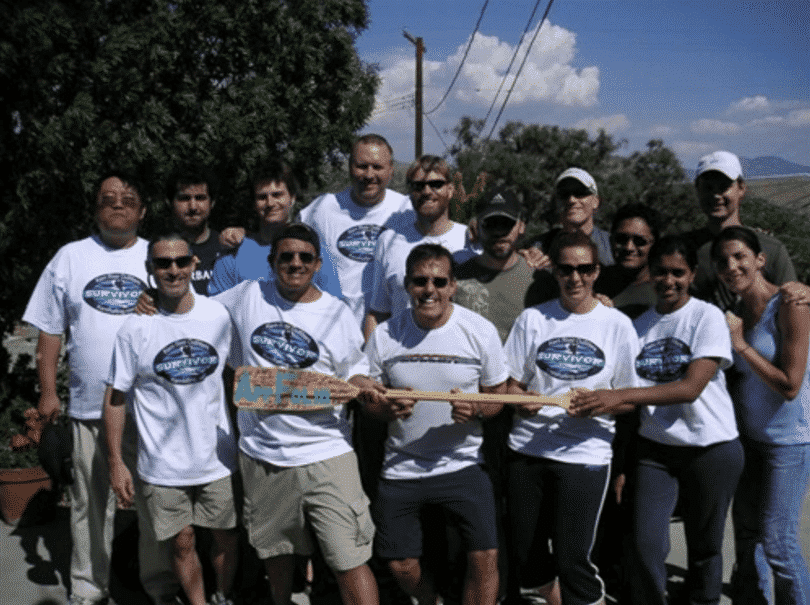
Photo of AppFolio as a startup after its inaugural tech retreat rafting on the Kern river.
Since we had the pact to always sit together with product and engineering, it seemed fitting to continue that vibe by inviting and having our product development teams go with us on every tech retreat. It’s now almost nine years later and the groups have gotten much larger. Still, all of the people who work on building the products together — engineers, QA, UX and product managers go on this annual trip together. It’s nothing short of epic! We have done camping at the Channel Islands together, white water rafting, high ropes, and have even been to Disneyland.
Teams have quarterly budgets to do local events together as celebrations to mark milestones, or they can do them just for the sake of bonding and getting to know each other better. This organizational support has helped us thrive, especially for the years in which our engineering and product teams doubled in size.
Often different groups also bond by going to conventions together, where we learn together and get to know each other in a setting apart from the office. We’d also plan and organize extra social events while in the corresponding city. Last year we were in Washington DC together, and we visited several sight seeing locations, and even rode a ferris wheel. In the photo below are two engineering directors, two agile coaches, three product managers, one UX engineer and one QA engineer. Having this shared learning and joyful experience brought us closer together and it was just plain fun.
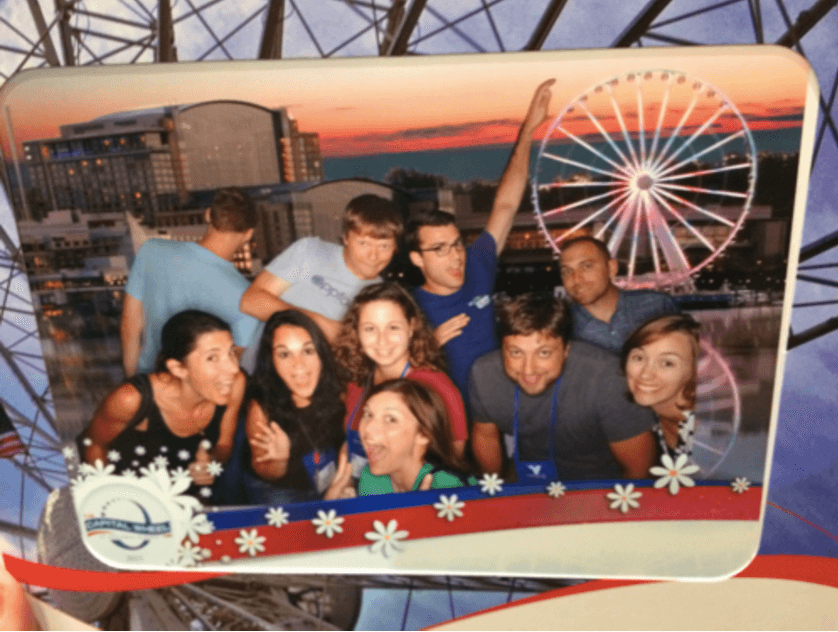
Photo of team members after they rode a large ferris wheel in Washington D.C.
Summary
Reflecting back on the experiences I have shared at both startups, I can tell you that relationship building is critical. As individuals, we are at our jobs to make money and to survive as independent people in the world. We spend more time at work typically than we do with our families. The time we spend with our co-workers, our friends, can include some of the most memorable and incredible times in our lives. We can work together and create incredible products for our customers, and love every minute of the experience together. If you know and care about the people you work with, everything else comes easier.
About the Guest Author:
Heidi Helfand has 17 years coaching and influencing cross-functional product development teams at pioneering web software companies. At Expertcity, Inc. (acquired by CitrixOnline) she was on the initial team that built GoToMyPC, GoToMeeting and GoToWebinar. She is currently Principal Agile Coach at AppFolio, Inc., a SAAS workflow software company with property management and legal practice management software. Prior to that, Heidi consulted for the State Dept. on website development, and has taught ESL at several US Universities. She has an M.A. in teaching from the University of Illinois at Urbana-Champaign and is a Certified Professional Co-Active Coach (CPCC) and Associate Certified Coach (ACC) through the International Coach Federation (ICF). Follow her on twitter @heidihelfand For more information visit heidihelfand.com
Acknowledgements
I would like to send out a special thanks to my AppFolio friends Jon Walker, Rahul Sawhney, Regina Rodwell, Jennifer Payne, and Ellie Thomas for their feedback on early drafts of this blog. I’d also like to thank Joshua Kerievsky of Industrial Logic for his thoughtful comments and encouragement.
References
- Rod, Anne & Fridjhon, Marita. “Creating Intelligent Teams” KR Publishing, 2016.
- Adkins, Lyssa. “Coaching Agile Teams: A Companion for ScrumMasters and Project Managers in Transition” Addison-Wesley Signature Series (Cohn), 2010.
- Kimsey-House, Henry; Kimsey-House, Karen, Sandahl, Philip, Whitworth, Laura. “Co-Active Coaching: Changing Business, Transforming Lives.” Nicholas Brealey America, 2011.
- Reichheld, Fred & Markey, Rob. “The Ultimate Question 2.0: How Net Promoter Companies Thrive in a Customer-Driven World.” Harvard Business Review Press, 2011.
- CRR Global, Organizational Relationship Systems Coaching (ORSC), http://www.crrglobal.com/coach-courses.html
